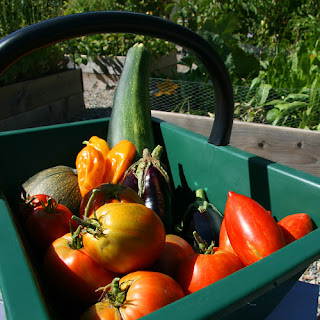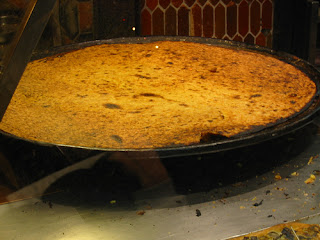from
Behind the French Menu
by
Bryan G. Newman
behindthefrenchmenu@gmail.com
Salade Niçoise
The Classic Salade
Niçoise
The classic Salad Niçoise was
an hors d’œuvre, an appetizer served before the first course, the French
entrée. The tradition of serving Salad Niçoise as an hors d’œuvre is now
more honored in the breach than in the observance. Today, a Salade Niçoise will
likely be a French entrée or the main dish when it its part of a light lunch.
Ordering Salade
Niçoise
With few exceptions, most chefs from Nice
agree that the recipe will include canned tuna or anchovies, but
not both. Then are added tomatoes, the black
Niçoise AOC olives, fava
beans, cooked baby artichokes, sweet
peppers, herbs, especially basil, and
a vinaigrette
dressing with the oil from Nice’s own AOP olive oil the, Huile
d'Olive de Nice and red wine vinegar.
Among the variations that are accepted
but considered later additions are
boiled potatoes, boiled eggs, spring onions, and boiled or steamed haricots
verts France’s favorite fresh bean that we call the green bean or snap
bean.
Haricot vert, the essential green bean in a Salade Niçoise
www.flickr.com/photos/olibac/4021008699/
Lettuce is often seen in a Salades
Nicoise today though it is generally agreed that it is a recent addition, and
it is still rare for a chef with Nice's culinary history on his or her mind to
include lettuce.
One word of advice, when in Nice do not
discuss with the locals the exact recipe as even the local gourmands disagree.
You might end up as I did with my head in my hands along with wine and opinions
coming from all sides even though we had finished dinner three hours
before.
Salade Niçoise first appeared on French
menus in the latter part of the 19th century; less than 30 years after Nice
lost its Italian rulers and became part of France. The name of the dish’s
original creator is lost, probably during the Franco-Prussian war that ended in
France becoming a Republic and Emperor
Napoléon III being exiled to England where he later died and is
buried.
The most authentic Salade Nicoise recipes
that I have seen are the two reported by the famous cookbook author Elizabeth
David (1913 – 1992). Her book French Provincial Cooking was published in
1960; however, I read the Penguin Books Edition published posthumously in 1999
with a forward by Julia Child.
The recipes Elizabeth David highlights
are from Henri Heyraud and Escoffier.
Henri Heraud’s recipe was from his book
La Cuisine a Nice, the cuisine of Nice. Henri Heyraud, was a chef, teacher and
historian of the cuisine served in France in the early 20th century,
In the footsteps of Escoffier
www.flickr.com/photos/edsel_/5880234487/
Henri Heraud’s recipe for Salade Niçoise:
Canned tuna in oil, peeled tomatoes and
diced anchovy fillets, all seasoned with tarragon, chervil, and
chopped chives and
prepared with or without mustard.
This recipe shows that the accepted
tradition where you can use tuna or anchovies, but not both was not there in
the early years. Heraud uses both tuna and anchovies, and the only vegetables
are tomatoes.
The recipe also offers no vinaigrette
dressing and the oil used is that that comes from the canned tuna. That
would be a very rare offering today, but Herault published his recipe in 1922.
Escoffier’s recipe
for Salade Niçoise:
Young
artichoke hearts, black
nice olives, uncooked sweet peppers, tomatoes and anchovy fillets all
served with a vinaigrette dressing made of olive oil, vinegar, salt, pepper, mustard
and the most important of French herb groups Les
Fine Herbes.
Canned anchovies.
Escoffier, a Provencal favorite son,
surprisingly does not use the Provencal herb group the Herbs
de Provence, instead, he chooses Les
Fine Herbes. Escoffier. uses anchovy fillets, and no option of tuna
is offered.
Nice and the
Cote-d’Azur.
The Cote-d’Azur, the azure or blue coast
was the name given to Nice and its coastal area in 1887 by the French writer
and poet Stephen Liégeard (1830 -1925). At that time the South of France
was being discovered by wealthy British tourists who came from the rainy UK to
the unclouded blue sky of coastal Provence.
The Promenade des Anglais in Nice.
www.flickr.com/photos/newmundane/5595810828/
Dining
in Nice with its French, Provençal and Italian influences makes the
visitor aware of the many other dishes that originated here including Ratatouille,
Pissaladiere, and Socca
Ratatouille
------------------------------------------
Behind the French Menu
by
Bryan G. Newman
behindthefrenchmenu@gmail.com
Copyright 2010, 2013, 2018, 2019
--------------------------------
Searching for the meaning of words, names
or phrases
on
French menus?
Just add the word, words, or phrase that you are searching for to
the words "Behind the French Menu" (best when including the inverted
commas), and search with Google, Bing, or another search
engine. Behind the French Menu’s links, include hundreds of words,
names, and phrases that are seen on French menus. There are over 450 articles
that include over 4,000 French dishes with English translations and
explanations.
Connected Posts:
Ratatouille,
the essence of Provencal cuisine and Ratatouille’s Ancestor, the Bohémienne de
Légumes.
Tomate
– Tomato. France’s Greatest Tomato, the Tomate de Marmande AOC. The Tomato in
French Cuisine.




















